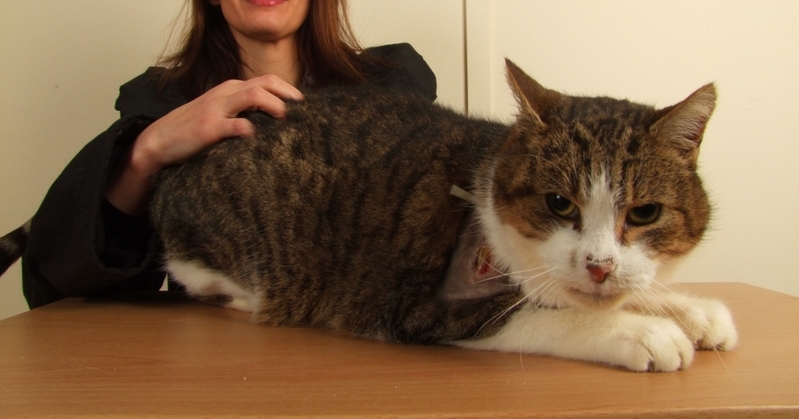Taz is an independent creature, choosing to live in his own cat house outside Hilary’s back door. It’s a cosy place, lined with newspaper, blankets and a comfortable cushion. He comes into Hilary’s home from time to time, but the cat house has always been his favourite sleeping place.
Hilary recently noticed that Taz had developed a limp. He was still as active and mobile as ever, but he was favouring his right foreleg, his head bobbing as he walked. She decided that a visit to the vet was in order, so she fetched the cat carrier in preparation for the trip.
Taz must have had some distant memory of the significance of the blue plastic cage: when Hilary went looking for him, he’d vanished. He didn’t come back for the next four days. She looked everywhere, but there was no sign of him. Then one evening last week, she heard a miaow: Taz was at the back door. The lameness was now much worse, and he was holding his right foreleg up, unable to put any weight on it at all. It was as if he’d come back, looking for help.
Hilary kept him indoors overnight, worried that if she let him sleep in his normal cat house, he’d disappear again. She brought him up to see me first thing the following morning.
When I examined Taz, it was obvious that the focus of the lameness was in his right shoulder, which was swollen and painful. The poor cat was not at all happy as I gently felt the sore area. I admitted him for a short anaesthetic, so that I could examine his shoulder more closely without hurting him.
Once he was anaesthetized, I was able to investigate his problem in closer detail. The area around his shoulder was swollen and puffy, and there was an accumulation of fluid under the skin. When I clipped the fur away, I could see four telltale puncture marks in the skin, in a rectangular pattern. Taz had obviously been bitten on his shoulder by another cat, and an abscess had developed. I had to lance the abscess, draining away the pus and infection that had gathered. I then inserted a latex drain, to make sure that the infection was thoroughly cleared out.
Hilary had noticed Taz mixing with other cats, but they had always seemed friendly. She’ll keep a closer watch on Taz’s social life in the future: a cat bite abscess is bad enough, but if a cat gets into regular fights, there’s also a risk of Feline Immunodeficiency Virus, the cat equivalent of HIV, which is spread by cat bites. If there’s a new bully in the area, it may be time to curtail Taz’s freedom.
Abscesses are painful, but they respond well to the right treatment. Taz was sent home on antibiotics and pain relief, and Hilary kept him inside, against his will, for the next three days. When he came back to have the drain removed, he was already walking normally. He still has a nasty wound, but it isn’t painful any more. Hilary will need to bathe the wound twice daily to keep it clean, but during the next ten days, it should gradually heal over.
I told Hilary that Taz was ready to return to his usual accommodation, as long as he avoids fights in the future. I spoke to Taz sternly: “Do you hear that Taz? One more fight and you’ll be grounded”. The big cat looked at me and yawned. Do you ever think cats know more than they let on to us?
Tips
- Bites from other cats are the most common cause of lameness in cats
- Minor bites may heal naturally, but antibiotics are usually advisable
- If an abscess forms, simple surgery is needed to allow it to heal

